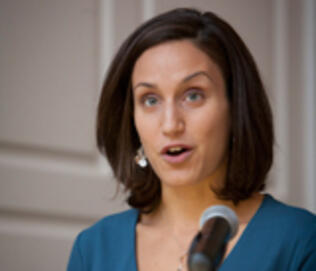
Creative Writing Award Winner - 2011
Class of 2013
Aislyn K. Cangialose graduated from Wellesley College in 2006 with a Bachelor of Arts in Psychology, and from the Health Careers Program at Harvard University. Prior to entering nursing, she worked as a clinical research coordinator at Children’s Hospital Boston. Aislyn entered YSN in 2010 to fulfill her goal of becoming a Pediatric Nurse Practitioner.
Transcript of the reading:
Cough
I stood freezing in the pediatric OR with a surgical mask over my face. I pushed air forcefully out of my mouth, like fogging up a mirror. I felt silly doing it, but I was desperate. The breath provided such a brief moment of warmth on my face; as soon as it came it went, and my mask started to feel soggy against the tip of my nose. I was waiting for the patient to arrive. The operating table was empty, the nurses were ready, and the anesthesiologist was showing some equipment to a nervously nodding medical student. I was just standing in the corner, fogging up my surgical mask. Before I saw her walk in, I knew the patient had cystic fibrosis. I knew she was 17. I immediately thought of my own 17 year old sister. She would walk in wearing make-up even though she was in a hospital gown, with hair that smelled fruity and edible, and bright colored nail polish. As I stood there fogging up my surgical mask and imagining my sister walk into the operating room, someone else arrived. She was short, not even 5 feet tall. She looked about 12 years-old, with curly wheat-brown hair and bright blue eyes. She was wearing thick mascara and eyeliner. It was very 17 of her, even though she couldn’t have been a day over 12. She hopped onto the operating table as if she had been there a thousand times, as if it were her own bed at home. She knew the drill. She told the anesthesiologist that she wanted the PICC line in her left arm, “that’s where they usually put it”, she said. That’s when the patient with cystic fibrosis laid down on the table. Of course she knew the drill; she must need to have her lungs cleared out by broncho-lavage on a regular basis. She needs that PICC line for antibiotics because she suffering through another bout of pneumonia. She can’t clear the thick mucus that builds up in her lungs, so she’s plagued with respiratory infections.
The surgeon began the procedure by confirming the patient to everyone in the OR, “this is Casey, she’s a 17 year-old female with cystic fibrosis, here for PICC line placement and broncoalveolar lavage”. The procedure began – the broncoscope made its way down her trachea for only a few seconds before it appeared that a blob of vanilla pudding was in the way. The surgeon sighed and shook her head in disappointment, but wasn’t surprised. The nurse pushed normal saline through the scope and the vanilla pudding swirled and separated and was suctioned out. The openings to the bronchi branches became clear, and the scope continued though, only to be stuck again in pudding. “Again” the surgeon said expectantly, and the nurse pushed the saline in hard and fast. The procedure went on like this for over an hour. Scope, pudding, saline, swirl, suction. Over a liter of thick sticky mucous was suctioned out of Casey’s lungs. As I stood over her and watched the video feed of the scope making its way through the vanilla pudding roadblocks in her airways, I focused on her face; her thick black mascara and eyeliner, the faint line of make-up at her chin that she didn’t rub in all the way, the subtle scent of apples and watermelon in her hair. How did this girl manage to walk in here today, hop on this operating table with these pudding-clogged lungs, and still look and smell just like my 17 year-old sister?
As Casey was coming to from the anesthesia, her chest began to rise off the table, her back arched and her neck flushed red with effort. She didn’t make a sound; her body just heaved upward slowly and came back down to the table. With each breath her chest would rise and her back would arch, as if someone was pushing her up from below. “Cough, Casey!” the surgeon encouraged. The surgeon cupped her hands and started pounding on Casey’s chest like a drum. She hit her hard, and Casey’s apple-watermelon curls bounced about on the table. The surgeon pounded again and again, harder and harder, then paused, took her cupped hands away and said again, “Cough, Casey, you can do it!” Casey’s chest heaved and the demanded cough escaped, loud and hard. Casey brought her hand up to cover her mouth, as I can only imagine she’s done countless times a day for 17 years, and I saw her painted finger nails. She wore a glossy cherry-red on her light bulb shaped fingertips. Her nails bulged from their beds, as the fingers below demanded more oxygen that her lungs couldn’t deliver. She took several minutes to cough, and the surgical team encouraged her with gentle smiles and pats on her back. As her coughs diminished and her awareness returned, Casey smiled back at her audience – “Thanks”.
